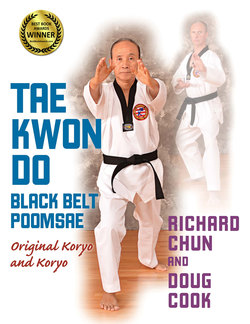Читать книгу Taekwondo Black Belt Poomsae - Richard Chun - Страница 5
На сайте Литреса книга снята с продажи.
ОглавлениеIntroduction
This book centers on the history, philosophy, and technical attributes of taekwondo poomsae: Original Koryo and Koryo. By far the most popular poomsae performed today by the advanced practitioner, the latter of the two, Koryo, represents a gateway to the complexities of 1st dan black belt and is a necessary component for promotion to 2nd dan as advocated by the Kukkiwon and the World Taekwondo Federation (WTF). With this in mind, we feel a detailed exploration of this poomsae is overdue both in a sense of fostering an appreciation for its heritage and in cultivating an understanding of its overall combat effectiveness aside from its competitive value in the ring.
Furthermore, initially established, as we shall see, between 1965 and 1967 along with the Palgwe set of poomsae intended as a vehicle for practice by the gup holder, Original Koryo is radically different from the Koryo we know of today. Consequently, practice of this primordial iteration has been uniformly subjugated in favor of its modern mate in part due to internal politics coupled with a desire to create a poomsae with enhanced complexity. Yet, Original Koryo continues to be transmitted from venerated master to worthy disciple in various taekwondo institutes to this day, albeit with highly attenuated frequency.
Koryo, in its present state, created in 1972 in conjunction with the Taegeuk series of elementary poomsae, effectively supplanted its earlier sibling and is today actively practiced by more than 90,000,000 World Taekwondo Federation stylists in over 200 nations around the globe. Given Koryo’s popularity and its challenging characteristics, it is routinely rehearsed in preparation for tournament competition at the regional, national, and international level. Moreover, documentation of this poomsae is profuse; written and video illustrations depicting the fundamental elements and unique line of motion are plentiful.
So why add to the exhaustive collection of editorial and visual documentation already available to the martial arts community at large on this subject? Succinctly put, poomsae, hyung, and tul clearly represent more than a loose collection of basic movements strung together for aesthetic or health purposes. The tactics, carefully annotated within the time-honored sequences of offensive and defensive strategies that combine to create both poomsae, are more in tune with combat preparedness than they are to sport, as they were originally intended. Relegating the execution of these tactics to a position leading to little more than the presentation of a trophy flies in the face of their authentic martial intent. Subsequently, while true completion of technique is denied by the overarching principle of honor and compassion prescribed by the tenets of traditional, defense-oriented taekwondo, it does not imply that the practitioner need remain ignorant to the practical defensive and offensive applications associated with the kicks, blocks, and strikes unique to both versions of Koryo as mapped out in a later section of this work.1
Likewise, both Koryo poomsae, by virtue of their imprimatur, bear the stamp of pride imprinted by Korean history. These distinctive poomsae honor the technical, cultural, and philosophical innovations of the Koryo dynasty while celebrating its accomplishments with each consecutive performance. Why not then pay tribute to this golden past by awakening to the historical dimensions of these formal exercises?
Moreover, we feel Original Koryo should be recognized as an heirloom form containing many tactical strategies not found in subsequent poomsae. Therefore, it is important to note that the reintroduction of Original Koryo is not intended to subvert the practice and proliferation of Koryo as an entity for global competition in any way.
Clearly, the vast majority of us are not soldiers; if we were training in taekwondo merely to inflict injury we would enlist in the military and master the use of firearms. Yet taekwondo, at least in its orthodox form, is also not dance. So why relegate these poomsae simply to the level of physical motion within the spatial plane as is so often done in the modern dojang?
This book then is a scholarly attempt to capture, transmit, and preserve as an inheritance not only the historical treasures and apparent technical elements inherent in Original Koryo and Koryo along with their properly calibrated stances, but also applications less obvious or even secretly encoded for the benefit of those seeking more than triumph in the ring or aerobic fulfillment from their taekwondo training.
Finally, previous books we have collectively authored have been standardized as reference materials within the global taekwondo community. It is our hope that this work will also be utilized as such.
Grandmaster Richard Chun
Master Doug Cook
1 Steven D. Carpener, “Problems in the Identity and Philosophy of T’aegwondo and Their Historical Causes,” in Korea Journal 35 no. 4 (Winter 1995): 80-94.
